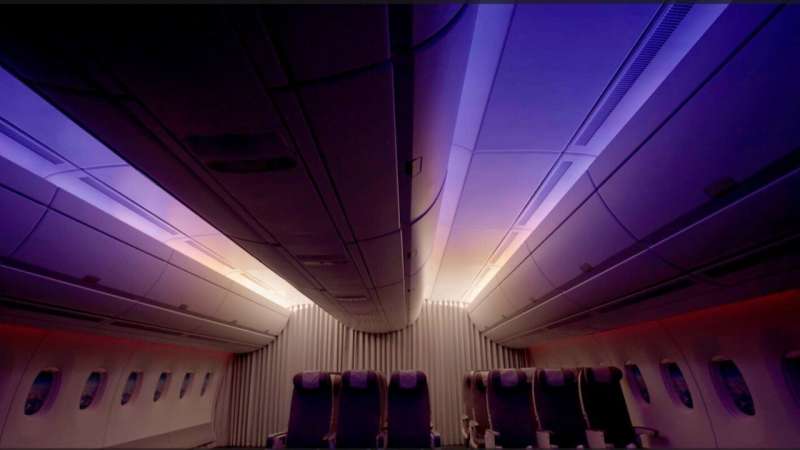This article has been reviewed according to Science X's editorial process and policies. Editors have highlighted the following attributes while ensuring the content's credibility:
fact-checked
trusted source
proofread
Aircraft cabin lighting design could help combat jet lag by aligning body clocks to destination's time zone

Cabin lighting inspired by the colors of the Australian landscape and grounded in circadian science will be on Qantas' upcoming Project Sunrise ultra-long-haul flights to help minimize jet lag and improve customer well-being.
The design, which includes simulations of sunsets and sunrises, is a result of more than 150 hours of testing in the Airbus Customer Definition Center in Hamburg, where representatives from the University of Sydney's Charles Perkins Center, Qantas, Airbus and Caon Design Studio created and tested hundreds of lighting patterns and sequences in an Airbus A350 cabin mock-up.
Light plays an important part in controlling our body clocks. By manipulating the timing, strength and wavelengths of light during a flight, it is possible to help passengers adapt to a destination's time zone while in the air and reduce jetlag.
Last year Qantas and the Charles Perkins Center released preliminary findings from the world-first research flights on how optimizing the timing of light, meals, and exercise in-flight affects jetlag. Now they are going one step further by adjusting the color of light.
"It's great to see circadian science being translated into practice," said Associate Professor Sveta Postnova, an expert in circadian modeling at the Charles Perkins Center and the School of Physics.
"The new lighting scenarios for the A350 were developed to optimize the circadian effects of light at different times during flights while accounting for the light appearance, ambience, safety, and hardware requirements on board. It was a true collaborative effort."
The trial produced 12 unique lighting scenes specifically for the Project Sunrise flights. Some of them include:
- "Awake": A broad-spectrum blue-enriched lighting to help customers adjust to the destination time zone and help them stay alert and awake
- "Sunset": An immersive transition from a daytime mode into dark that moves through the colors of a sunset into a night sky with moonlight and slow cloud effects to relax customers and prepare them for sleep.
- "Sunrise": Dynamic lighting effective for a transition from night to day that replicates an Australian sunrise rolling from the front of the cabin to the rear.
The Charles Perkins Center advised the wavelengths for light that most strongly affect a person's body clock, using melanopic illuminance.
Regular illuminance is a phenomenon that tells our body how bright light is for our eyes. Melanopic illuminance is the impact of that light on our circadian rhythm. High melanopic illuminance means a lot of light is available to adjust the brain's central clock.
The researchers found blue-enriched light with high melanopic illuminance helps shift body clocks, and long-wavelength light (such as red) with low melanopic illuminance helps prevent the clock shifting in an undesired direction.
Various scenarios were implemented and tested, and adjusted for eye comfort and appearance, during lighting workshops held in Hamburg.
Lighting sequences are tailored for each flight to help passengers adjust to destination time zones before they land.
Qantas International CEO Cam Wallace said that the scientifically informed lighting design was another critical component of the preparation for Project Sunrise flights, which will connect Australia's east coast non-stop with London and New York.
"These world-first flights have been an opportunity for us to work with experts and build on our experience of long-haul flying to rethink the inflight experience with a focus on customer well-being and combating the effects of jetlag," said Wallace.
"One of the things that was clear from the research is the importance of light cycles and brightness in setting the body clock and that was the basis of this testing.
"Combined with the design of the cabins, specialized meal planning, and the movement program, this unique lighting sequence will help improve our customers' comfort in the air and minimize their jetlag when they arrive at their destination."
The airline revealed the customized lighting schemes at Airbus' Airspace Customer Showroom in Toulouse, where a life-size mock-up of the Project Sunrise Well-being Zone is being temporarily displayed.





















